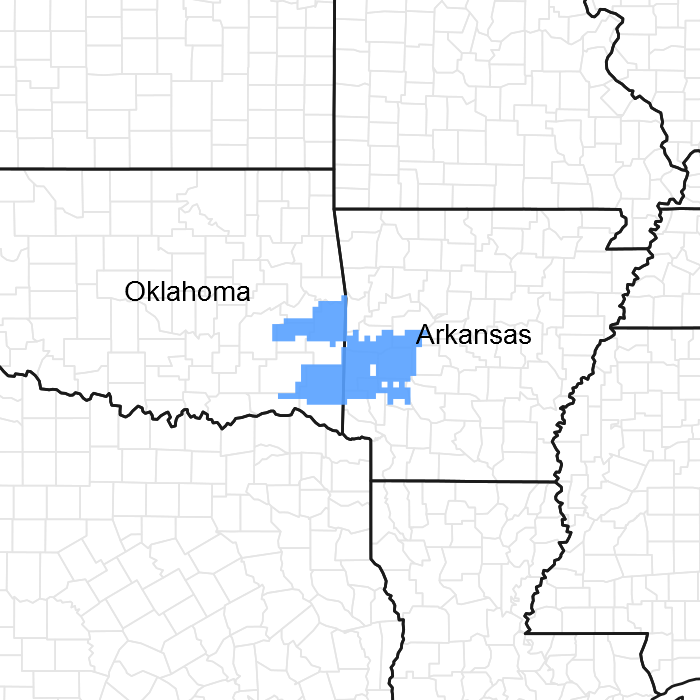Ecological dynamics
Information contained in this section was adapted from Missouri ESD. The information presented is representative of very complex vegetation communities. Key indicator plants, animals and ecological processes are described to help inform land management decisions. Plant communities will differ across the MLRA because of the naturally occurring variability in weather, soils, and aspect. The Reference Plant Community is not necessarily the management goal. The species lists are representative and are not botanical descriptions of all species occurring, or potentially occurring, on this site. They are not intended to cover every situation or the full range of conditions, species, and responses for the site.
The reference community Rubbly Shallow Backslope is closed woodland with a moderately developed canopy (65 to 90 feet tall and 60 to 80 percent canopy closure) dominated by white oak and shortleaf pine. Compared to the uplands above or adjacent exposed slopes, these are often one of the more productive sites in their vicinity. The moderately deep soils and occasional fires make this community transitional between woodland and forest, with more open woodland conditions being created briefly after the periodic fires and denser forest conditions during fire free intervals. These sites likely had an abundance of several huckleberry species, along with a diverse array of native legumes, asters, sunflowers and other forbs. Woodlands are distinguished from forests by their relatively open understory and the presence of sun-loving ground flora species.
Historically, Rubbly Shallow Backslope Woodlands were also subjected to occasional disturbances from wind and ice, as well as grazing by native large herbivores, such as bison, elk, and deer. Wind and ice would have periodically opened the canopy up by knocking over trees or breaking substantial branches off canopy trees. Grazing by native herbivores would have effectively kept understory conditions more open, creating conditions more favorable to oak reproduction and ground flora species.
Species composition and structure of the reference plant community varied for this ecological site based on its relative location to the Ouachita Mountains historic native shortleaf pine range. Fragmentary evidence from old records indicate that the original timber stands in the Ouachita Mountains contained a large volume of shortleaf pine on relatively few, concentrated areas, (green area on preceding map) but a relatively small volume of shortleaf pine on extensive areas (cross-hatched area on preceding map) (Fletcher and McDermott, 1957). Because of this situation, this ecological site is classified into two community phases. When the ecological site occurs outside of the historic native pine range, the community phase expressed is a well-developed Oak Woodland dominated by an overstory of white oak, black oak and scarlet oak. Within the historic native pine range, the community phase is characterized as Oak-Pine Woodland, with shortleaf pine as a common overstory species. Soil gravels, doughtiness, low soil bases and complicated landscape complexes are unifying soil features of these rather divergent community phases.
The Oak Woodland phase of Rubbly Shallow Backslope Woodland is a woodland with a moderately developed canopy (60 to 80 feet tall and 65 to 85 percent canopy closure) dominated by white oak and shortleaf pine. Increased light from the more open canopy causes a diversity of ground flora species to flourish. Within the historical native pine range this ecological site contained drought and fire-tolerant shortleaf pine, with occasional to frequent black oak and white oak. Canopy closure likely varied from 60 to 80 percent and tree height from 70 to 90 feet. Native prairie grasses dominated the open understory, along with a diverse mix of native legumes, asters, sunflowers and other forbs. Most of this oak-pine community was cleared by extensive logging around 1890 to1920. Consequently, persistent sprouting of oak species, especially black and scarlet oak, replaced the pine.
Today, dense, even age stands of oak have replaced much of this community. Most occurrences today exhibit canopy closure of 80 to 100 percent with a greatly diminished ground flora. In the long term absence of fire, woody species, especially scarlet oak, hickory, and black oak have increased in these woodlands. Once established, these woodies can quickly fill the woodland system.
Uncontrolled domestic grazing is also impacting these communities, further diminishing the diversity of native plants and introducing invasive species that are tolerant of grazing, such as buckbrush, gooseberry, Virginia creeper. Grazed sites also have a more open understory. In addition, soil compaction and soil loss from grazing can lower site productivity.
These ecological sites are moderately productive. Some areas have been cleared for non-native pasture, but many areas have been repeatedly logged and high graded. Maintenance of the oak component will require disturbances that encourage more sun adapted species and reduce shading effects. Characteristic plants in the ground flora can be used to gauge the restoration potential of a stand along with remnant open-grown old-age trees. Removal of the younger understory and the application of prescribed fire have proven to be effective management applications. Despite the widespread removal of pine from this ecological type, there are many areas with some pine present on this ecological site. Where present, selective cutting and prescribed fire can help recruit pine, restore the more open structure, and increase the diversity of ground flora species.
A State and Transition Diagram is depicted in Figure 1. Detailed descriptions of each state, transition, plant community, and pathway follow the model. This model is based on available experimental research, field observations, professional consensus, and interpretations. It is likely to change as knowledge increases.
State 1
reference
Historically, these woodlands occurred on the uplands of most major rivers of the region. The restricted soil depth, droughty conditions, and native grasses made them susceptible to frequent fires, once every 3 to 5 years. During fire-free intervals, eastern red cedar, along with hickories and oak sprouts, increased in abundance and competed with the herbaceous ground flora, creating more brushy woodland



